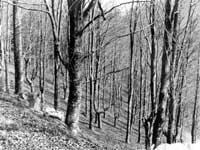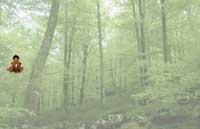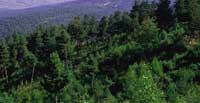The forest future in Euskal Herria
he recognizes that he has a low forest culture, he has always been interested in the subject because he has never forgotten his first trade.

× Ismael Mondragon

Basque forest planning was carried out in 1994 and sets targets for the next 25 years. Therefore, the ones I will give below will be the main brushstrokes of this plan.
The forest plan orders the territory, noting the areas of exploitation and the areas of protection. According to the plan, it would be convenient for the administration to buy and protect more mountains. If it is not acquired, it would be necessary to grant assistance to private owners for the correct execution of the works.
Fiscal treatment must be improved because forests demand an ecological and social benefit that is used throughout society. Investments in forests are short-term, small and high-risk, so they often do not arouse investors' attention. If tax treatment is improved, more responsibility may be required for individuals.
We need to improve the environmental trend in forestry, analyzing what damage occurs and how things can be improved. Knowing that the properties of individuals are small, it would be appropriate to put them together to make a more suitable exploitation.
As in other areas of life, planning points to the convenience of driving research. Genetic improvement of the main species is being carried out and it is necessary to continue with it, but not only from the point of view of production, but also of how to deal with diseases.

On the other hand, it is necessary to enhance the safety and professionalism of mountain workers, since the sector is not professionalized at all. There are many immigrants in the mountains, coming from Morocco or Portugal, and most are in bad shape.
Awareness is also critical. Bring forestry activity to the public from school. We observe the environment, but without leaving the fauna and vegetation, we must bear in mind that the human being is part of the environment and that we must look at his needs. Campaigns should be made to raise public awareness of the risk of fire.
Finally, if we have to talk about the future, I would say that we have to see and compare what has been before. According to data from the Autonomous Community of the Basque Country, compared to those of 24 years ago, there has been an increase of 36,000 ha, representing a total of 390,000 ha. In 1972 it was covered by 66% conifers and 34% leafy, compared to 56% and 44%. On the other hand, the surface of the signis has been reduced by 12,000 ha, which has generated concern for lack of wood, etc. has been heard. The pine forest has been reduced below 200 meters and can be due to urbanization, and in some places, after the demolition, it has not been replanted and the leafy have emerged naturally.
× Balentin Gabilondo

I am not yet 50 years old, but before I say how I see the future, I would also like to go back saying that conifer planting began about 50 years ago. The peasants began to plant inexperienced and as an adventure, especially with the pine sign. Our forest, especially that forest of beech and heather, and our land of wheat, and the mountain and meadow Euskal Herria has gone, at least in appearance and color, darkening. I won't say that's bad for us, but this change has occurred in the last 50 years. At his side and little by little an old and transformative industry has been established. The industry has developed around the forest and it is he who pulls selviculture, as it needs wood.
As seen in Hego Euskal Herria, the forest has its logic and it is no coincidence that those clean mountains that existed today are forests. Gipuzkoa and Bizkaia are mountain farming regions, very mountainous, and their mountainous character hinders livestock and agricultural work. At their side are the villages of Hego Euskal Herria, small but industrial villages, which has led farmers to work in the industry and to be a steep country has been increasingly cultivated. The various varieties introduced, especially the pine insignis, have given a good production, which places us in a mountainous village with many forests. We must recognize the role of the forest and recognize the benefit of the forest, which has many good things for nature and society.

An adequate forest policy for the future? I see clearly the need for a condition and general planning. I am a peasant, I live on the mountain, I have forests, I also have meadows, and as I see in my neighborhood, in my environment, in the village and in the neighboring provinces. Today anyone cultivates it in the meadows, anyone is planting it or transforming forests that were pine forests, everyone does more or less what they want. Both the municipalities, with their competence, and the Councils would say that they have to make a general planning. What you can’t do is put pine in any flat meadow, two kilometers away you see transforming the forest in any slope… I’m still talking about extreme cases, but it’s a reality, and vice versa, on much more appropriate terrain for the forest you see that people are playing with the cows and the tractor. Planning is essential.
Diversification. It has been promoted in recent years, not only is the pine insignis grown, but from a certain altitude there are spruces or ledges. This diversification is also necessary within planning. Models of tracks, taxes, etc. have been mentioned and should be taken into account in planning.

It is also important to establish what kind of forests we want. I think that in relation to diversification, fir trees are more suitable than the insignis in many places, in others it is more appropriate than the fir insignis, also the native ones, and inside the leafy we need all kinds of plants. Many times we turn to the simplest and say: Let the administration be the one that you saw leafy forests in the area for municipalities to introduce them. Since it is not oriented to economic benefit, it may be the Administration itself that initiates the introduction of leafy, but it is also necessary to help farmers by compensating hardwoods owners. We would have to make a balanced forest, but above all we need leafy forests that have culturally existed in our history. And this would relate to the research mentioned above.
Fires have also been mentioned and are very important. In the last 7-8 years we have been lucky, but in 1988-89 they were terrible. Once again we must mention that the Basque Country is mountainous and industrial, the mountains are crossed by cables, the climate is different... and within forest policy for the future, firewalls are very important, as they can cause enormous damage. And social awareness is very important, for farmers, for forest owners, for everyone. Society is aware of what is on the mountain, what farmers do, but there is a huge lack of awareness about the importance of this role. Farmers' associations, trade unions, administration and public institutions have a lot to do in this area.
Recent searches

Just a couple of ideas. How do I see the future? If it is not black, at least difficult. Why? Balentin said we are beginning to diversify, but I think diversification on the mountain is scarce and low. Here is the insinis or the beech, and little more, that are those that exist in the market and especially the insignis. No one knows what will happen to you within 5 years. What happened 7-8 years ago can happen, that the market goes down, that the owners earn little and that some companies go to pillory.
I think before that you have to diversify it. 40 years ago, some without experience and taking the risk, began to introduce the insignis completely. From now on, by diversifying the market, we will not make any sin, considering that our way of life is not on those trees. Forestry is only part of the income of the garbage dumps. Therefore, I propose to have an income equal to or greater than the cultivation of the forest otherwise. I would like to ask: If in 30-35 or 40 years we could get the same income with native species, would we discard insinis and other species?
And in that sense I mean that everyone, mountain engineers, politicians, mountain workers... normally we limit ourselves, we always say what beech, 1,000 ha, 100 years... To see if we can get out of there and see that there are different things
× Josu Azparte

I have to highlight two or three things. On the one hand, all forests have three main functions: the economic, the indispensable; the social, from the moment that forest use and protective function have existed. These three functions should be present in all forests, giving priority to one or the other, but maintaining all three. This compatibility is mandatory, but in some cases one or the other must be reinforced.
In the whole of Euskal Herria there is a fairly balanced situation, while in Bizkaia and Gipuzkoa conifers have a greater weight, in Álava, Navarra and Iparralde the situation is more balanced. From the point of view of Gipuzkoa and Bizkaia, I think we will agree on the need to maintain and improve spaces with native vegetation. Some public forests, of natural interest, should adapt to the native vegetation and be prepared by the Administration itself on demand of the society itself. And in the particular forests to protect would have to promote protection, but with aid.
On the other hand, I think that in some forests that can withstand intensive forestry it is necessary to continue as now. The first principle should last. In Euskal Herria it is necessary to professionalize the forestry sector, since so far it has been worked without model. Since these lands are productive, we must aim to increase production, without increasing the area, to obtain greater production by improving work: genetic improvement, forest health care and use of advanced techniques. I believe that we must defend wood as a raw material and as a raw material respectful of nature, renewable and unpolluting. A correct execution of the work will help preserve nature.
Jacques Kazabon

The situation in Iparralde is very different today. There are those great high mountain forests, beautiful and well managed, and then there are empty and empty mountains, a lot. At the beginning of this century, in the high mountains there were more forests than now. In Baja Navarra and Zuberoa have always been large forests, well managed; in Laburdi there are municipal forests, which in their day were beautiful, but which have been drastically reduced. And then the individuals. At the beginning of this century there were 40,000 hectares of individuals, but the pests stripped the mountains. Nothing has been done after these pests, not even a study has been done to see if something else could be grown. We have arrived little by little, with 15,000 ha.
The peasant of the North has not had the opportunity of the South, because no industry has come here. We have not had that luck, the peasant has been hooked to his land in another way and Euskal Herria has emptied, lowering the number of farmers in half. At one point the polyculture was made (wheat, corn, turnip, cheese, milk, cattle, sheep...) and, as could not be otherwise, the cultivation has begun. The farmer has great institutional aid, premium per head, half of the benefits currently come from Europe. Primaries increase the number of animals, stems, rotations and meadows.
The farmer lives on one leg if the aid is reduced – ready! There is no sensitivity in favor of the tree, they consider it an enemy because we have no culture and we have to live. The former farmers introduced the trees and knew they were not for them. That has been lost. What will happen? I don't know, I also see the dark future in that sense, and I prefer to see it that way, because if we have many forests, surely here we will not have human beings.
I believe that in all the hamlets there are lands, both for livestock and for forests, ravines, escarpments, etc. You can't make large forests, and I'm against it, because I don't see it as a profitability. The emptiness in this sense is the conservation of nature, since in the lands of individuals and municipalities there is room for the introduction of trees, here a couple of beeches, there one, in another place three… We have to sensitize people… to say that the future looks dark and that we run the risk of losing our huge treasure.





